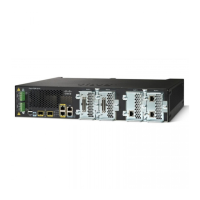15-2
Catalyst 3550 Multilayer Switch Software Configuration Guide
78-11194-09
Chapter 15 Configuring 802.1Q and Layer 2 Protocol Tunneling
Understanding 802.1Q Tunneling
Customer traffic tagged in the normal way with appropriate VLAN IDs comes from an 802.1Q trunk port
on the customer device and into a tunnel port on the SP edge switch. The link between the customer
device and the edge switch is asymmetric because one end is configured as an 802.1Q trunk port, and
the other end is configured as a tunnel port. You assign the tunnel port interface to an access VLAN ID
that is unique to each customer. See Figure 15-1.
Figure 15-1 802.1Q Tunnel Ports in a SP Network
Packets coming from the customer trunk port into the tunnel port on the SP edge switch are normally
802.1Q-tagged with the appropriate VLAN ID. When the tagged packets exit the trunk port into the
SP network, they are encapsulated with another layer of an 802.1Q tag (called the metro tag) that
contains the VLAN ID that is unique to the customer. The original customer 802.1Q tag is preserved in
the encapsulated packet. Therefore, packets entering the SP network are double-tagged, with the metro
tag containing the customer’s access VLAN ID, and the inner VLAN ID being that of the incoming
traffic.
When the double-tagged packet enters another trunk port in a SP core switch, the metro tag is stripped
as the switch processes the packet. When the packet exits another trunk port on the same core switch,
the same metro tag is again added to the packet. Figure 15-2 shows the tag structures of the Ethernet
packets starting with the original, or normal, frame.
Customer A
VLANs 1 to 100
Customer B
VLANs 1 to 200
Customer B
VLANs 1 to 200
Customer A
VLANs 1 to 100
Tunnel port
VLAN 40
Tunnel port
VLAN 30
Trunk
ports
Trunk
ports
Tunnel port
VLAN 30
Tunnel port
VLAN 40
Service
provider
74016
Trunk
Asymmetric link
Tunnel port
VLAN 30

